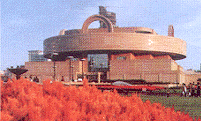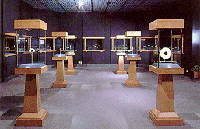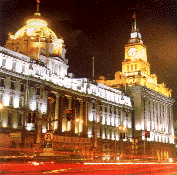Immediately to the west of the Forbidden City is a large lake area which court officials of the Qing Dynasty called the Western Lake (Xihaizi) or the Pool of Great Secretion (Taiyechi). Centuries ago, this stretch of water was divided into three sections- North Lake (Beihai), Central Lake (Zhonghai) and South lake (Nanhai). The area between Xinhuamen (New China) Gate on Chang’ an Boulevard in the south and Yingtai (SEA terrace Island) in the north is called South Lake. The area north of the Hall of Diligent Government (Qinzhengdian) and south of the Hall of Endless Blessings (Wanshandian) is called Central Lake. It is connected to South Lake by a lock near the old eastern gate. The area north of the Hall of Received Brilliance (Chengguangdian) and south of the Five-Drag-on Pavilions (Wulongting) is known as North Lake or Beihai. A long white marble bridge-the Golden Tortoise Jade Rainbow Bridge-divided Central Lake from North Lake. The water supply for the lakes comes from the Jade Spring Mountain (Yuquanshan) to the west of Beijing and enters the city at the Deshengmen (Moral Victory) Gate in the northwest corner of the old city.
The fine natural hills and ponds in this area inspired the emperors of the Liao Dynasty to choose it as their pleasure park. During the Jin Dynasty, North Lake became the site of the emperors’ winter palace. In the Yuan Dynasty, the lakes were enclosed as part of the Imperial Palace in the new Mongol capital of Dadu, and the lakes were called the pool of Great Secretion (Taiyechi). The lakes were then widened and deepened, and the mud dredged heaped up to the north of the Forbidden City to form Prospect Hill (Jingshan). They attained their present dimensions of two kilometers from north to south and, at their widest point, 200 meters from east to west.
When Emperor Yongle rebuilt the Imperial Palace in 1417, he extended the walls to enclose both the former Yuan palace and gardens to the west. In the Ming and Qing, the area became known as the Western Gardens (Xiyuan) and continued to serve palace residents as a place of leisure. During the Qing Dynasty, refurbishment of the area continued on a grand scale. The majority of the structures and relics, which remain today date from that period.
After the demise of the Qing Dynasty in 1911, Zhongnanhai (the Central and South Lakes) were turned into a park for a short period of time and served as the headquarters of the government of Yuan Shikai. It is now the headquarters of the Central Committee of the Chinese Communist Party and the State Council of the People’ s Republic of China.
Nanhai (the South Lake)
The main gate of South Lake is Xinhuamen (New China) Gate, which was originally known as the Precious Moon Tower. This was the famous Gazing Home Tower (Wangxianlou) built by Emperor Qianlong for his favorite Muslim Concubine Xiang (Fragrant Consort). To remind this homesick lady if her native Kashgaria (in present-day Xinjiang). Qianlong had a mosque and Islamic-style marketplace built within view of the tower. After the establishment of the Republic of China in 1912, the Xinhuamen (New China) Gate was refurbished and the signboard for Yuan Shikai’ s presidential residence was hung here.
The gate is today the official entrance to the headquarters of the people’ s government, but visitors to the scenic areas must enter by a gate at 81 Nanchang Street. A short distance to the north, one comes to a pavilion, the floor of which contains stone-lined channel which makes nine turns. The bubbling of the water in the channel gives this spot the name Flowing Water Music (Liushuiyin). To the west is the Hall of Diligent Government (Qinzhengdian) where Emperor Guangxu administered affairs of state. When Yuan Shikai took up residence in Nanhai, he rebuilt the hall in Western-style and used it to receive foreign guests.
To the south is a curving bridge to the Sea Terrace Island (Yingtai), which is actually a peninsula in the South Lake. The tall granite structure on the other side of the bridge is the Southern Terrace (Nantai), the principal viewing place in this section of the park. The buildings here date from the reigns of emperors Shunzhi (1644-1661) and Kangxi (1662-1722). Among the dozen or so poetically named pavilions, gates, halls and towers, we shall only mention the following: the Hall of the Fragrant Screen (Xiangyidian), where there is a room set aside for drinking tea; the Fairy Isles Pavilion (Penglaige), next to which stands a specimen of fossilized pine nearly three meters tall-an inscription nearby attributes the stone to the Six Dynasties period (220-589); on each side of this stone are several flower beds, and in front of it a stone bridge which leads to a pavilion on the water known as the Welcoming Fragrance Pavilion (Yingxunting), where there are numerous stone inscriptions praising the virtues and achievements of the emperors. Looking south across the water from there, one can see the north side of the screen wall, which stands directly inside New China Gate.
Among the other relics on the island are a group of imitation stalagmites inscribed with the calligraphy of Emperor Qianlong and another stone inscription in the same emperor’ s hand commemorating a willow tree in the shape of the Chinese character for man which once stood on this spot. A limb of this willow was bent by a strong wind, and some kind soul moored one of its branches to the ground to support the rest of the tree. This branch actually took root and the resulting grotesquely shaped tree so delighted Emperor Qianlong that he composed a prose poem about it.
The Sea Terrace Island was one of the favorite summer resort spots of Qing emperors. Kangxi and Qianlong both administered the empire from here, and after the failure of the Reform Movement of 1898, Emperor Guangxu was imprisoned here by Empress Dowager Cixi. He died in 1908 in the Hanyuan (Cherishing the Origin) Palace. In the early years of the Republican period, Yuan Shikai arranged for Li yuanhong, vice-president of the Republic, to make his residence here. After the establishment of the People’ Republic of China in 1949, various departments of the State Council made use of its many halls to hold private small-scale industrial exhibitions. A major restoration project was completed in 1975.
Northwest from the Sea Terrace Island, one comes to the Garden of Plenty (Fengzeyuan), in which there is a small plot of land called the Trial Sowing Grounds (Yangengdi) where the Qing emperors rehearsed on a somewhat smaller scale the plowing ceremony held at the Altar of the God of Agriculture. One particular rehearsal which took place in 1888 is recorded in the diary of Weng Tonghe, Emperor Guangxu’ s tutor: Shortly after 9 a.m. the emperor arrived at the yellow tent by palanquin, rested for a short while, and removed his long gown. Officials presented him with a plow and a whip, and Weng Tonghe sowed the seeds. Two old peasants led the oxen, and with imperial guards supporting the plow, the emperor sowed four furrows. His Majesty then rested in the yellow tent and frank tea before returning to the palace. Having been touched by the dragon hands of the emperor, this ceremonial plow became a sacred object. It is now on display in the Palace Museum.
Mao Zedong’s former residence, a traditional Beijing home built around a courtyard, is also here in the Garden of Plenty. Chairman Mao occupied the rooms on the northern side of the courtyard; the rooms to the west now display his personal effects; his office and bedroom to the east remain exactly as before, with the late Mao’ s desk, bathrobe and slippers on display. In Qing times, these rooms were known as the Library of Chrysanthemum Fragrance.
To the west of the Garden of Plenty is the Pavilion of Lotus Breeze and Orchid-Scented Dew (Hefenghuiluting), and immediately to the south, an elegant white marble gateway with the inscription Peaceful Valley (Jinggu) carved into its lintel.
In addition, a number of other buildings not yet open to the public are worthy of mention. The Hall of the Calm Sea (Haiyantang), a Western-style structure, was formerly used by Cixi for entertaining women guests. The hall is furnished with chairs and tables in Louis XY style imported from France. When Yuan Shikai came into power, he changed its name to the Hall of Benevolence (Jerentang) and continued to use it for entertaining visitors. In 1927, when the warlord Zhang Zuolin took over Beijing, he made the Hall of Benevolence his home. And in 1923, when the warlord Cao Kun was president of the Republic, he too made his offices here. When the Christian General Feng Yuxiang captured Cao, it became his prison.
In the South Lake district, there is an interesting set of 10 square stones, each inscribed with a poem written by different people. Though the nearby Swastika Corridor (Wanzilang) has been torn down, to the south of its former site stands the Stone Chamber (Shishi), built entirely of white marble. Inside the chamber is a golden casket –actually a gilded safe — which played a critical role in the history of the early Republic. In 1914, Yuan Shikai reformed the Laws for Electing the President by having the names of three reselected candidates for his succession-including his own-placed inside the safe. When the time came, his specially appointed parliament had little choice but to choose Yuan as the new president.
The most impressive in the South Lake area are the groves of old trees, elms conspicuous for their absence. One day in 1883, Empress Dowager Cixi was out for a stroll when a caterpillar fell from an infested elm and stung her hand. Enraged she ordered all the elm trees in that area cut down.
Zhonghai (the Central Lake)
The area north of the Hall of Diligent Government to Fuhuamen Gate is full of pre-and post-liberation buildings which, with the exception of the Hall of Embracing Benevolence (Huairentang), are not open to the public.
The Hall of Embracing Benevolence is the most important building in the Central Lake area. It was originally the site of the Hall of Imperial Pomp (Yiluandian), which was destroyed by the Eight-power Allied Forces. When Cixi returned to Beijing from Xi’ an, she spent more than 5 million silver dollars to erect a Tower of Buddhist Reflections (Fozhaolou). During the first year of the Republic of China (1912), the tower’ s name was changed to the Hall of Embracing Benevolence. The National Assembly and other governing bodies of the early Republic met here. After Yuan Shikai’ s death, the former president’s coffin was kept here temporarily. After 1949, the hall was used for meetings of the First People’ s Political Consultative Conference and other important political bodies. In front of the hall is a display of cultural relic: 12 bronze statues with animal heads and human torsos; bronze lions decorated with cloisonne; commemorative tablets; and images of the 12 animal signs used to symbolize the year in which a person is born. Local school children are occasionally brought to visit.
On the northwest bank of the Central Lake is another important structure, the tower of Vermilion Light (Ziguangge), also called the Flat Terrace (Pingtai), where Emperor Zhengde (reigned 1506-1521) of the Ming Dynasty watched his troops practice calisthenics and archery. These displays continued during the Qing Dynasty when portraits of meritorious officials from past dynasties hung inside the tower’s hall. In the first lunar month of every year, the emperor would hold a banquet here in honor of his ministers. Fine old maps and paintings are preserved in the tower in excellent condition.
The northeast bank of the Central Lake is the location of the famous Plantain Garden (Jiaoyuan) or Virtuous Garden, the former site of the Ming Dynasty Palace of Sublime Wisdom (Chongzhidian). The path leading north along the eastern side of the lake is lined with scholar, willow and fruit trees as well as pavilions and small decorative buildings. During the Qianlong period (1736-1796), the Plantain Garden served as a schoolroom for the younger eunuchs who lived in the palace. On the Buddhist Ghost Festival, celebrated on the evening of the 15th day of the seventh lunar month, floating lanterns were sent out to sea, turning the lakes into a field of twinkling stars.
To the north of the Plantain Garden is the Temple of Endless Blessings (Wanshandian). The main hall contains images of the Three Buddhas — the Goddess of Mercy (Guanyin), Manjusri (Wenshu) and Samantabhadra (Puxian) — and the eighteen disciples of Buddha (Luohan). At the rear of the main hall is a statue of the Goddess of Mercy of the Southern Seas (Nanhai Guanyin). The Hall if a Thousand Buddhas stands tot eh rear of this temple complex with an octagonal sandalwood pagoda seven storied high dating from the Ming Dynasty. Other halls house sculptural representations of legendary emperors, Buddhas and other gods and immortals. Of particular interest is the Hall of the Dragon Kings (Longwangtang) housing images of the dragon kings, which govern streams, rivers, lakes and seas.
From the eastern gate of the Plantain Garden walking north, one will pass a small hill and pond before coming to a thatched gate. Continuing down the path, there is the Pavilion of Clouds on the Water (Shuiyunxie). Its name is derived from the way it appears to float amidst clouds reflected on the lake.
A large stone tablet inscribed with the calligraphy of Emperor Qianlong, Autumn Winds on Taiye, immortalizes this spot as one of the Eight Great Sights of Yanjing.
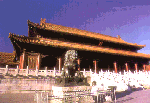
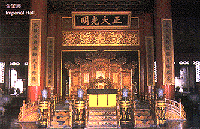 The palace occupies an area of some 720,000 square-meter with over 9,000 rooms. Historical records showed that it took up to one million laborers and 100,000 artisans to complete the construction project. Original construction materials came from all parts of the country. in the Ming Dy-nasty, the timber needed for building the palace was brought mostly from Sichuan, Hunan and Guangdong Provinces, while in the Qing Dynasty timber from northeast territories were used for renovations and ex-pansions. Bricks with a light golden color were used to pave the floors of the inte- rior halls. Although they are not made of real gold, but since they were spe cially made in Suzhou and cost a good fortune, so people called them gold bricks anyway. All the structures employed red brick walls and yellow glass tiles for the roof. The main buildings were arranged with utmost care to form sym-metrical patterns. The overall layout of the palatial complex place strong emphasis on reflecting the dignity of the emperor and is a master piece of Chinese palatial con-struction. The 1911 civil revolution brought an end to the Qing Dynasty and also marked the con-clusion of the two thous-and years of autocratic feudalism in China. However, the last emperor Po Yi stayed in the palace for thirteen years after the dethroning. Until November 5, 1924, People’s Army drove Po Yi away from the palace and re-named it Palace Museum on October 10, l925 .
The palace occupies an area of some 720,000 square-meter with over 9,000 rooms. Historical records showed that it took up to one million laborers and 100,000 artisans to complete the construction project. Original construction materials came from all parts of the country. in the Ming Dy-nasty, the timber needed for building the palace was brought mostly from Sichuan, Hunan and Guangdong Provinces, while in the Qing Dynasty timber from northeast territories were used for renovations and ex-pansions. Bricks with a light golden color were used to pave the floors of the inte- rior halls. Although they are not made of real gold, but since they were spe cially made in Suzhou and cost a good fortune, so people called them gold bricks anyway. All the structures employed red brick walls and yellow glass tiles for the roof. The main buildings were arranged with utmost care to form sym-metrical patterns. The overall layout of the palatial complex place strong emphasis on reflecting the dignity of the emperor and is a master piece of Chinese palatial con-struction. The 1911 civil revolution brought an end to the Qing Dynasty and also marked the con-clusion of the two thous-and years of autocratic feudalism in China. However, the last emperor Po Yi stayed in the palace for thirteen years after the dethroning. Until November 5, 1924, People’s Army drove Po Yi away from the palace and re-named it Palace Museum on October 10, l925 .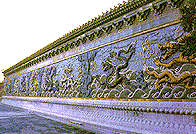 The Palace Museum is the largest museum in China, with a vast collection of art crafts pieces from ancient times up to the Qing Dynasty. After the founding of the People’s Republic of China in 1945, the museum has under-gone several large scale renovations. Massive compilation works had been carried out over the years to preserve this important historical monument for the viewing of local and overseas tourists.
The Palace Museum is the largest museum in China, with a vast collection of art crafts pieces from ancient times up to the Qing Dynasty. After the founding of the People’s Republic of China in 1945, the museum has under-gone several large scale renovations. Massive compilation works had been carried out over the years to preserve this important historical monument for the viewing of local and overseas tourists.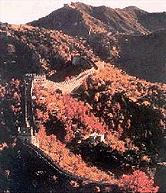 The Mutianyu Grate Wall The section of the Great Wall at Mutianyu is within the bound-aries of Huairou County, 70 km northeast of Beijing. It is one of the sixteen famous scenes in Beijing. Mutianyu joins Juyong Pass in the west and Gubei Entrance in the east. Together with Badaling, it is the quintes-sence of the Great Wall in the Ming Dynasty. On the section of the Great Wall at Mutian-yu the watchtowers are very closely spaced, varied in style and refined in construcion. The Zheng Guan Tower is a building on which three watchtowers crowd together. It is imposing, novel and unique, an asset of the Great Wall. Gazing into the distance on this section of the Great Wall, you are presented with a splendid sight. The wall changes with the mountain slope, leaping onto the peaks one moment, slipping into the low valleys the next, just like a huge dragon rising and ready to fly to the sky. The tourist district of Mutianyu is relatively well equipped in services. A cablecaris buiilt whereby tourists ride cable cars to climb the Great Wall.
The Mutianyu Grate Wall The section of the Great Wall at Mutianyu is within the bound-aries of Huairou County, 70 km northeast of Beijing. It is one of the sixteen famous scenes in Beijing. Mutianyu joins Juyong Pass in the west and Gubei Entrance in the east. Together with Badaling, it is the quintes-sence of the Great Wall in the Ming Dynasty. On the section of the Great Wall at Mutian-yu the watchtowers are very closely spaced, varied in style and refined in construcion. The Zheng Guan Tower is a building on which three watchtowers crowd together. It is imposing, novel and unique, an asset of the Great Wall. Gazing into the distance on this section of the Great Wall, you are presented with a splendid sight. The wall changes with the mountain slope, leaping onto the peaks one moment, slipping into the low valleys the next, just like a huge dragon rising and ready to fly to the sky. The tourist district of Mutianyu is relatively well equipped in services. A cablecaris buiilt whereby tourists ride cable cars to climb the Great Wall.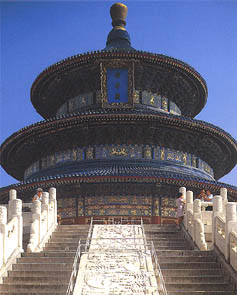 The Temple of Heaven is the most holy of Beijing’s Imperial temples. For this is where the Emperor came every winter solstice to worship heaven and to solemnly pray for a good harvest. Since his rule was legitimised by a mandate from heaven, a bad harvest could be interpreted as his fall from heaven’s favour and threaten the stability of his reign. So, it was not without a measure of self-interest that the Emperor fervently prayed for a very good crop.
The Temple of Heaven is the most holy of Beijing’s Imperial temples. For this is where the Emperor came every winter solstice to worship heaven and to solemnly pray for a good harvest. Since his rule was legitimised by a mandate from heaven, a bad harvest could be interpreted as his fall from heaven’s favour and threaten the stability of his reign. So, it was not without a measure of self-interest that the Emperor fervently prayed for a very good crop.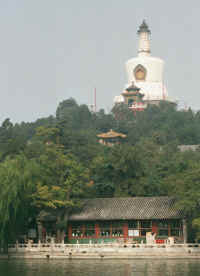 About one bus stop, or half a kilometer to the west of the north gate of the Forbidden City is the famous Beihai Park. It is used to be the former palace of the emperors in successive dynasties, called the Winter Palace by Westerners.
About one bus stop, or half a kilometer to the west of the north gate of the Forbidden City is the famous Beihai Park. It is used to be the former palace of the emperors in successive dynasties, called the Winter Palace by Westerners.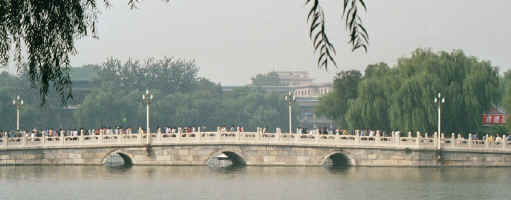 Besides the lake, the main things to see are the Round City, which contains a jade vase from the time of Kublai Khan; the Temple of Eternal Peace; the Nine Dragon Screen, which is actually a 5-metre-high, 27-metre-long wall covered with glazed tiles carved into nine intertwining dragons; and the White Dagoba on Jade Isle in the center of the lake.
Besides the lake, the main things to see are the Round City, which contains a jade vase from the time of Kublai Khan; the Temple of Eternal Peace; the Nine Dragon Screen, which is actually a 5-metre-high, 27-metre-long wall covered with glazed tiles carved into nine intertwining dragons; and the White Dagoba on Jade Isle in the center of the lake.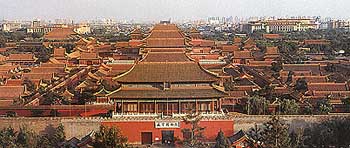 Home of the Emperor, the Forbidden Palace was constructed in accordance with the laws of geomancy or fengshui. Every element was considered according to its prescriptions, the most fundamental being the positioning of the palace along a north-south axis.
Home of the Emperor, the Forbidden Palace was constructed in accordance with the laws of geomancy or fengshui. Every element was considered according to its prescriptions, the most fundamental being the positioning of the palace along a north-south axis.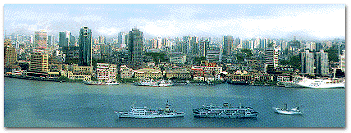 Riding a cruise boat along the Huangpu River. you will take a glimpse of the today and yesterday of Shanghai. On one side of the river. there is the Bund, a landmark of Shanghai. Lining the boulevard of the waterfront are grandiose solid buildings of Western style dating back to the early this century. You will also see the Park bridge. the first toll bridge in Shanghai; the People’s Heroes Monument and Huangpu Park, the city’s first park. On the other side is the image of a new Shanghai. Lofty Oriental pearl TV Tower and sleek high-rises in the Lujiazui Financial Zone give a fresh outlook of the city. On the cruise, you will also marvel at the two giant suspended bridges over the river. Cargo slips that sail to and fro on the river will make you realize how busy the trading business is ongoing in this most bustling trade outlet of China. Sailing further northward, you might be impressed by the scale of industrial plants, such as the steel giant Baosteel.The cruise will end at Wusongkou, where the Huangpu River flows into the East China Sea.
Riding a cruise boat along the Huangpu River. you will take a glimpse of the today and yesterday of Shanghai. On one side of the river. there is the Bund, a landmark of Shanghai. Lining the boulevard of the waterfront are grandiose solid buildings of Western style dating back to the early this century. You will also see the Park bridge. the first toll bridge in Shanghai; the People’s Heroes Monument and Huangpu Park, the city’s first park. On the other side is the image of a new Shanghai. Lofty Oriental pearl TV Tower and sleek high-rises in the Lujiazui Financial Zone give a fresh outlook of the city. On the cruise, you will also marvel at the two giant suspended bridges over the river. Cargo slips that sail to and fro on the river will make you realize how busy the trading business is ongoing in this most bustling trade outlet of China. Sailing further northward, you might be impressed by the scale of industrial plants, such as the steel giant Baosteel.The cruise will end at Wusongkou, where the Huangpu River flows into the East China Sea.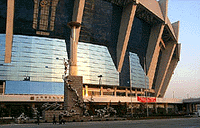 Shanghai Stadium is a giant sports facility boasts unique designing. Covering a floor area of 190,000 square meters, the stadium is a sphere in an radium of 300 meters. The saddle-shaped stadium has a total construction space of 150,000 square meters Above audiences’ stands there are awnings that could be spread out in case of raining and big sun. The stadium can seat 80,000 audiences. In addition to playing host to sports games and performances, the stadium also has facilities for dining, accommodation, conferences and exhibitions. The exhibition hall at the southern part of the stadium can play host to various seminars and press conferences.
Shanghai Stadium is a giant sports facility boasts unique designing. Covering a floor area of 190,000 square meters, the stadium is a sphere in an radium of 300 meters. The saddle-shaped stadium has a total construction space of 150,000 square meters Above audiences’ stands there are awnings that could be spread out in case of raining and big sun. The stadium can seat 80,000 audiences. In addition to playing host to sports games and performances, the stadium also has facilities for dining, accommodation, conferences and exhibitions. The exhibition hall at the southern part of the stadium can play host to various seminars and press conferences.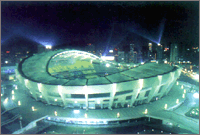
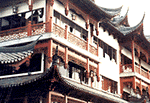
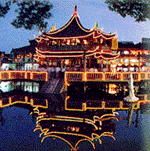 Built beside the Temple of the City God and covering only fives acres, it follows the Suzhou garden design of a world in microcosm, with 30 pavillions linked by corridors, artificial hills, bridges over lotus pools, groves of bamboo and walls occupied by stone dragons. The surrpounding bazaar is packed with traditional and modern shops, restaurants and temples.
Built beside the Temple of the City God and covering only fives acres, it follows the Suzhou garden design of a world in microcosm, with 30 pavillions linked by corridors, artificial hills, bridges over lotus pools, groves of bamboo and walls occupied by stone dragons. The surrpounding bazaar is packed with traditional and modern shops, restaurants and temples. Located in Chenxiang Town, Jiading County, the Qiuxia Pu Garden(Autumn Clouds Garden) was built in 1502(Ming Dynasty). It is the oldest garden in Shanghai and one of the famous classical gardens in the south of China. When first built, it had 10 sites such as shuyuzhai, Sanyintang, Goufengling, Yingyudi, Suihanjing, Baiwutai, Taohuatan, etc.
Located in Chenxiang Town, Jiading County, the Qiuxia Pu Garden(Autumn Clouds Garden) was built in 1502(Ming Dynasty). It is the oldest garden in Shanghai and one of the famous classical gardens in the south of China. When first built, it had 10 sites such as shuyuzhai, Sanyintang, Goufengling, Yingyudi, Suihanjing, Baiwutai, Taohuatan, etc. Located on Zhongshan Road(E) of Songjiang County, the Fang Ta was erected in Yuan You period of the Song Dynasty(949-1094 AD.),has a history of 400 years. It is one of the best-known pagodas south of the Yangtse River and follows the type of Buddhist square pagoda of Tang Dynasty. In front of the Square Pagoda stands a brick screen wall on which is sculptured a legendary creature named “Tan” featuring deer’s antlers, lion’s tail , dragon’s scale and ox’s hoofs.
Located on Zhongshan Road(E) of Songjiang County, the Fang Ta was erected in Yuan You period of the Song Dynasty(949-1094 AD.),has a history of 400 years. It is one of the best-known pagodas south of the Yangtse River and follows the type of Buddhist square pagoda of Tang Dynasty. In front of the Square Pagoda stands a brick screen wall on which is sculptured a legendary creature named “Tan” featuring deer’s antlers, lion’s tail , dragon’s scale and ox’s hoofs.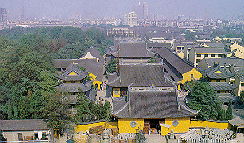
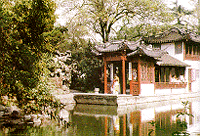 Situated in the town of Nanxiang, Jiading County, the Guyi (Ancient Splendour) Garden was built in 1566(Ming Dynasty). The name of the garden stemmed from “the beauty of green bamboo”. Its main structures are pavilions, corridors and winding paths. The Tang stela inscribed with Buddhist scriptures and a stone tower of the Song dynasty are famous works of art.
Situated in the town of Nanxiang, Jiading County, the Guyi (Ancient Splendour) Garden was built in 1566(Ming Dynasty). The name of the garden stemmed from “the beauty of green bamboo”. Its main structures are pavilions, corridors and winding paths. The Tang stela inscribed with Buddhist scriptures and a stone tower of the Song dynasty are famous works of art.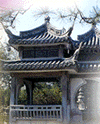 This calssic Chinese garden, laid out under the Ming dynasty in the 16th century, is the site of two stone pillars dating back to the Tang and Song dynasties. In its grounds is The United Boat- a pavillion in the form of a boat.
This calssic Chinese garden, laid out under the Ming dynasty in the 16th century, is the site of two stone pillars dating back to the Tang and Song dynasties. In its grounds is The United Boat- a pavillion in the form of a boat.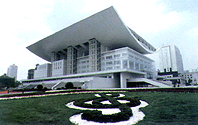 Shanghai Grand Theater is at the northern part of the People’s Square,at the intersection of the square’s Central Boulevard and Huangpi Road.The theater covers a floor space of 11,528 square meters. The east-west length of the theater is about 120 meters and the south-north length is about 1,378 meters. The modern and grandeur theater has 10 floors. Total construction space is 62,803 square meters.
Shanghai Grand Theater is at the northern part of the People’s Square,at the intersection of the square’s Central Boulevard and Huangpi Road.The theater covers a floor space of 11,528 square meters. The east-west length of the theater is about 120 meters and the south-north length is about 1,378 meters. The modern and grandeur theater has 10 floors. Total construction space is 62,803 square meters.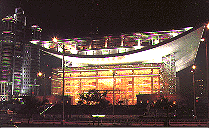 The theater has a 2,000-seat audience hall and a 760-square-meter hall for VIPs. (The backstage is 420 square meters and the two side-stages each has around 280 square meters of space). The theater will play host to performances of top-notch ballet troupes, opera troupes and symphony orchestras. Near the arch-like ceiling of the theater is a 500-plus-seat multi-functional ballroom where banquets, fashion shows and exhibitions can be held.
The theater has a 2,000-seat audience hall and a 760-square-meter hall for VIPs. (The backstage is 420 square meters and the two side-stages each has around 280 square meters of space). The theater will play host to performances of top-notch ballet troupes, opera troupes and symphony orchestras. Near the arch-like ceiling of the theater is a 500-plus-seat multi-functional ballroom where banquets, fashion shows and exhibitions can be held.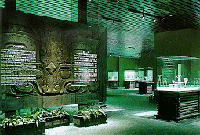 Shanghai Museum is situated at the southern side of the People’s Square. Total construction space is 38,000 square meters. The museum structure, 29.5 meters in height, includes five floors aboveground and two floors underground. Total investment of the museum is 432.69 million yuan. The museum opened to visitors at the end of 1995.
Shanghai Museum is situated at the southern side of the People’s Square. Total construction space is 38,000 square meters. The museum structure, 29.5 meters in height, includes five floors aboveground and two floors underground. Total investment of the museum is 432.69 million yuan. The museum opened to visitors at the end of 1995.